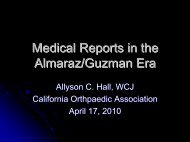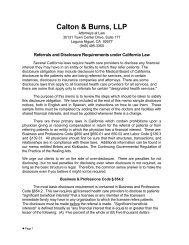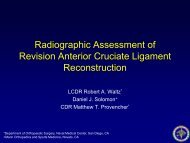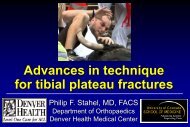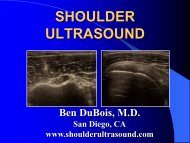Enhancing Your Practice's Revenue - California Orthopaedic ...
Enhancing Your Practice's Revenue - California Orthopaedic ...
Enhancing Your Practice's Revenue - California Orthopaedic ...
- No tags were found...
You also want an ePaper? Increase the reach of your titles
YUMPU automatically turns print PDFs into web optimized ePapers that Google loves.
existing ASCs will not longer have – this could generatesignificant ill-will with associated financial consequences.• The time horizon for developing an ASC ranges froma few months to more than 18. During this period,the facility will generate no revenue, but costs will beincurred. Physicians need to take this into accountbefore they make the decision to invest. One or moreadditional capital calls may be required.• Many ASCs market themselves very actively (especiallyif they are owned in full or in part by hospitals orhospital chains). However, there is no data indicatingthat patients choose an ASC facility because it has beenactively marketed; most simply follow their surgeon tothe recommended facility.• While there is no requirement at this juncture todisclose, it may be advisable for a physician practiceto clearly indicate on its website – and in any patientliterature – that it owns “ABC Ambulatory SurgeryCenter.” That way, patients can make an informeddecision regarding whether or not “ABC” is where theywish to receive care.• Although physicians frequently wish to develop ASCsindependent of hospital involvement, the reality is thatpartnering with a hospital in an ASC joint venturesometimes is better for both parties. Trends towardimproved reimbursement for hospitals coupled withdeclining payments for physicians have forced somedoctors involved with ASCs to accept the clout thathospitals have with payers, which results in greaternegotiating potential and better contracts.The Last WordExcerpt from AAOS Position Statement 1161: “ASCsprovide a benefit to both patients and orthopaedic surgeonsbecause many musculoskeletal surgical procedures can beprovided in an efficient, cost-effective manner. ASCs canimprove the quality of care received by the patient anddelivered by the physician.”Further, from the standpoint of this author, physicianownership/investment in ASCs may restore a sense ofcontrol in quality healthcare delivery to involved surgeons,allowing them to take back some control of their practiceand provision of health care. It also serves as a viable sourceof revenue generation.Contact: Douglas Turgeon, MD:drt@dallasorthosports.comChapter 6Imaging ServicesBy Dale Reigle, MSBackgroundImaging has become an integral part of many orthopaedicoffices. In-house imaging provides an ancillary revenuestream, improves practice efficiency, and may play a role inoverall patient satisfaction. The types of imaging servicesoffered vary depending on a variety of factors which includebut are not limited to practice size, geographical location,political considerations, and orthopaedic specialtiesrepresented in the office.<strong>Revenue</strong>s from imaging services can add significantlyto your bottom line. A reasonably busy MRI for examplemay generate more revenue and profit for the practice thanan orthopaedic surgeon, while X-ray often generates anadditional $50,000 - $100,000 or more of operating profitper orthopaedic surgeon. Other imaging equipment, bycontrast, such as bone densitometry (Dual Energy X-rayAbsorptiometry – DEXA for short), has proven to be lessprofitable or unprofitable for many practices.Practice control over imaging services, including qualitymanagement and scheduling, are non-financial factors thatoften help drive the decision to acquire new imaging equipment.It would be difficult to run a highly efficient orthopaedicoffice without X-ray in-house. Ultimately the mostexpensive resource in a medical practice is the physician.Maximizing physician efficiency should always be a highpriority and imaging is an important element. Prompt,easy access to advanced imaging services such as MagneticResonance Imaging (MRI) can help improve patient satisfaction.If competing MRI providers have a waiting list thatdelays care by even a few days, this can be a strong negotiatingpoint in contracting, especially for Workers’ Compensationcarriers that are very sensitive to lost time at work.Several expenses are associated with imaging services andmust be evaluated when making the decision to add orupgrade services offered in your office. Imaging equipmentoften requires a significant up-front capital outlay thatcan range from tens of thousands of dollars to well over amillion. Therefore it is important that a practice exercisedue diligence in performing a cost/return and cost/benefitanalysis of the service line. Capital decisions of this magnitudegenerally require evaluation of purchase/lease optionsas well as tax and cash flow implications in both the shortand long term. Note, however, that in many cases equipmentcan be acquired in the second hand market.In addition to the cost of the equipment, most practicesopt for after-warranty service and maintenance contracts toensure access to quick support and upgrades. The costs ofsuch contracts are often 8% - 12% of the original purchase22© 2011 American Academy of <strong>Orthopaedic</strong> Surgeons




